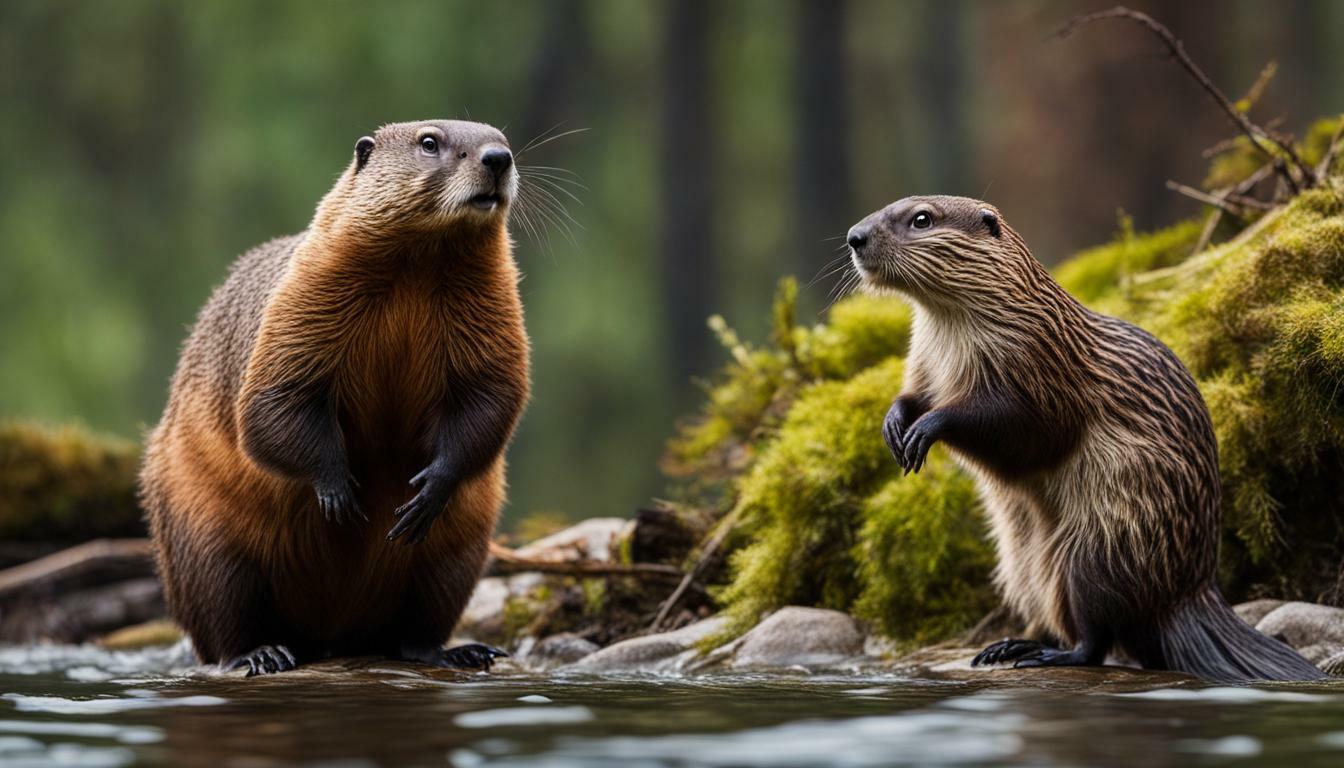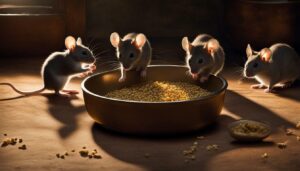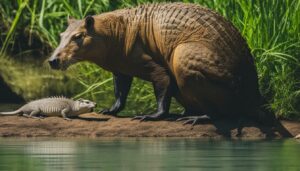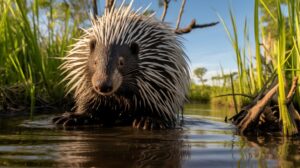Have you ever wondered if woodchucks and beavers are the same animal? In this article, we will explore the fascinating similarities and differences between these two wildlife species.
Key Takeaways:
- Woodchucks and beavers are distinct animals with noticeable differences in appearance, nesting habits, and behavior.
- Woodchucks have short, bushy tails and white front teeth, while beavers have flat, rudder-like tails and yellow incisors.
- Beavers are aquatic animals that live in colonies and build dams, while woodchucks are mostly land animals that live alone and dig burrows.
- Beavers cause more destruction with their dams, leading to flooding, while woodchucks cause damage by eating garden plants and digging burrows.
- Controlling infestations of beavers and woodchucks is possible, but seeking professional assistance is recommended for safe and humane control methods.
Woodchuck Characteristics
Woodchucks, also known as groundhogs, have distinct features that set them apart from beavers. These herbivorous creatures have short, bushy tails and are known for their rotund appearance. As members of the squirrel family, woodchucks have a similar body shape with stout legs and sharp claws that enable them to dig extensive burrows.
One of the distinctive characteristics of woodchucks is their white front teeth, which continuously grow throughout their lives. These sharp incisors are essential for their feeding habits, enabling them to gnaw on vegetation, including grasses, leaves, and bark.
Woodchucks are primarily terrestrial animals. They prefer open areas with a combination of woods and fields, where they can build their burrows. These burrows serve as their homes and provide protection from predators. Woodchucks are solitary animals and are generally not social, although they may share their burrows with other woodchucks during the winter months.
| Woodchuck Characteristics | |
|---|---|
| Tail | Short and bushy |
| Teeth | White front teeth that continuously grow |
| Habitat | Terrestrial, prefers open areas with woods and fields |
| Behavior | Solitary, builds burrows as homes and protection |
In summary, woodchucks have specific characteristics that set them apart from beavers. Their short, bushy tails, white front teeth, and solitary behavior distinguish them as terrestrial animals. Understanding these characteristics is essential for distinguishing woodchucks from their aquatic counterparts, the beavers.
Beaver Traits
Beavers possess remarkable traits that differentiate them from woodchucks and make them well-suited for their aquatic lifestyle. These traits include their unique physical characteristics, nesting habits, and behavior.
Physically, beavers have flat, rudder-like tails, which they use as a powerful tool for swimming and maneuvering through water. Their tails are covered in scales and have a leathery texture, allowing them to effectively navigate their watery habitats. In contrast, woodchucks have short, bushy tails that are not adapted for aquatic environments.
Another distinctive trait of beavers is their yellow incisors. These teeth are continuously growing and are well-suited for gnawing through tree trunks and branches, which they use to build dams and lodges. Woodchucks, on the other hand, have white front teeth that are primarily used for chewing vegetation.
Table: Beaver Traits
| Traits | Beavers | Woodchucks |
|---|---|---|
| Tail | Flat, rudder-like | Short, bushy |
| Front Teeth | Yellow incisors | White front teeth |
Behaviorally, beavers are highly social animals that live in colonies known as “lodges.” These lodges, constructed with mud and sticks, provide a safe haven for beavers and serve as their primary dwelling. In contrast, woodchucks are solitary animals that dig burrows underground, which they use for shelter and protection.
In conclusion, the unique traits of beavers set them apart from woodchucks and enable them to thrive in their aquatic habitats. From their flat, rudder-like tails to their yellow incisors and social behavior, beavers are truly fascinating creatures. Understanding these traits helps us appreciate the diversity of nature and the remarkable adaptations that different species have developed to survive in their respective environments.
Differences between Woodchucks and Beavers
Woodchucks and beavers may share some similarities, but they have notable differences in various aspects of their lives. When it comes to appearance, woodchucks have short, bushy tails and white front teeth, while beavers have flat, rudder-like tails and yellow incisors. These distinctions are not just cosmetic; they reflect the different habitats and behaviors of these fascinating creatures.
While beavers are aquatic animals that thrive in wet environments, woodchucks are mostly land dwellers. Beavers live in colonies and are known for their exceptional engineering skills, building dams that create ponds and protect their lodges. On the other hand, woodchucks are solitary animals that prefer digging burrows in open areas, using these underground dens for shelter and hibernation. Their burrows have complex tunnel systems with separate chambers for different purposes.
The impact of these animals on their surroundings is also quite different. Beavers, with their powerful dam-building abilities, can cause significant damage. Their dams can lead to flooding in certain areas, altering the landscape and impacting other wildlife. Woodchucks, although less destructive, can be a nuisance to gardeners and landscapers. They have a voracious appetite for garden plants and are known to dig burrows in lawns, which can be unsightly and problematic.
If you find yourself dealing with an infestation of beavers or woodchucks, it’s important to seek professional assistance for safe and humane control methods. Handling these animals without the proper knowledge and expertise can be both dangerous and ineffective. Professionals can provide solutions tailored to specific situations and ensure that the animals are safely relocated or managed.
| Woodchucks | Beavers |
|---|---|
| Short, bushy tails | Flat, rudder-like tails |
| White front teeth | Yellow incisors |
| Land animals | Aquatic animals |
| Solitary | Live in colonies |
| Dig burrows | Build dams and lodges |
| Eat garden plants | Alter landscapes with dams |
Similarities between Woodchucks and Beavers
While woodchucks and beavers may seem worlds apart, there are intriguing similarities that connect these two species. Despite their distinct characteristics and behaviors, both woodchucks and beavers belong to the rodent family and share certain commonalities.
One noticeable similarity is their herbivorous diet. Both woodchucks and beavers primarily feed on plant material, such as grasses, leaves, and bark. Their feeding habits can have a significant impact on their environment, as they shape vegetation patterns and contribute to the overall ecosystem.
Another similarity lies in their ability to carve and shape their surroundings. Beavers are renowned for their engineering skills, constructing complex dams and lodges using branches, mud, and rocks. Similarly, woodchucks demonstrate impressive excavation abilities, creating extensive burrow systems underground.
Similarities between Woodchucks and Beavers Table
| Similarities | Woodchucks | Beavers |
|---|---|---|
| Diet | Herbivorous – feed on plant material | Herbivorous – feed on plant material |
| Environmental Impact | Shape vegetation patterns | Shape vegetation patterns |
| Shaping Surroundings | Create extensive burrow systems | Construct complex dams and lodges |
Despite these similarities, it is crucial to note the significant differences between woodchucks and beavers. Understanding these distinctions is essential for comprehending the unique roles and behaviors of these fascinating creatures.
So while woodchucks and beavers may share common ground in certain aspects, their specific adaptations and lifestyles set them apart in the animal kingdom. Appreciating both their similarities and differences allows us to admire the diversity of nature and the remarkable ways in which different species thrive in their respective habitats.
Woodchuck Diet
Woodchucks have a specialized diet that primarily consists of vegetation, which influences their feeding habits and habitat selection. These herbivores are known for consuming a variety of plants, including grasses, clovers, dandelions, and certain tree barks. Their strong incisors enable them to gnaw through tough vegetation, making them efficient foragers in their environment.
Their feeding habits are more active during the spring and summer months when fresh vegetation is abundant. Woodchucks spend a significant amount of time grazing and browsing on plants, allowing them to stock up on food reserves for the winter. This behavior contributes to their preference for open fields, meadows, and woodlands where they can easily access a diverse range of plant species.
It is important to note that woodchucks have a selective diet and are known to avoid certain plants that are toxic or unpalatable to them. Their selective feeding habits help regulate their population and maintain a balanced ecosystem. While they may venture into gardens and consume crops, implementing deterrents and protective measures can help minimize damage caused by woodchucks in residential areas.
| Preferred Vegetation | Avoided Plants |
|---|---|
| Grasses | Tomatoes |
| Clovers | Eggplants |
| Dandelions | Peppers |
| Tree Barks | Potatoes |
To discourage woodchucks from wreaking havoc in gardens, individuals can consider using repellents, erecting fencing, or implementing scare tactics. Properly managing vegetation and maintaining a clean outdoor space can also help deter woodchucks from taking up residence on residential properties. If woodchuck infestations become unmanageable or pose a threat, it is advisable to seek professional assistance for safe and humane control methods.
Beaver Habitat and Behavior
Beavers and woodchucks have distinct preferences when it comes to their habitats and behaviors, showcasing their unique adaptations to their respective environments.
Beavers, as aquatic animals, are most commonly found in areas with abundant water sources such as rivers, streams, and lakes. They are excellent swimmers and have webbed hind feet, making them well-equipped for their semi-aquatic lifestyle. These industrious creatures build dams using branches, mud, and rocks, creating deep ponds that provide protection from predators and a stable environment for their lodges. Beavers are known for their exceptional engineering skills, which contribute to the creation of complex wetland ecosystems that support a wide variety of plant and animal species.
On the other hand, woodchucks, also known as groundhogs, are primarily land-dwelling creatures. They prefer open areas such as fields, meadows, and woodlands, where they can easily forage for their herbivorous diet. Woodchucks are skilled diggers and create extensive burrow systems, complete with multiple entrances and chambers. These burrows serve as their homes and provide protection from predators and harsh weather conditions. Although woodchucks are capable of swimming, they are not as adept in the water as beavers and generally avoid areas with large bodies of water.
In summary, while beavers thrive in aquatic environments, relying on their dam-building abilities to shape their habitats, woodchucks prefer terrestrial habitats where they can dig extensive burrows. These contrasting habitat preferences and behaviors allow both species to adapt to their surroundings and fulfill their ecological roles within their respective ecosystems.
| Beavers | Woodchucks |
|---|---|
| Aquatic animals | Land-dwelling creatures |
| Build dams and lodges | Create extensive burrow systems |
| Prefer areas with abundant water sources | Adapt to open areas such as fields and meadows |
| Excellent swimmers with webbed hind feet | Capable of swimming, but not as proficient as beavers |
| Contribute to the creation of complex wetland ecosystems | Play a role in maintaining biodiversity in terrestrial ecosystems |
Damages Caused by Beavers and Woodchucks
Both beavers and woodchucks can cause various forms of damage, albeit in different ways, posing challenges for homeowners and landowners. Understanding the nature of these damages can help in implementing effective control strategies.
Beavers, with their remarkable adaptations for aquatic life, are known for building dams on rivers and streams. These dams serve as their homes, creating ponds that provide protection and easy access to food sources. However, these structures can also lead to flooding, potentially causing damage to surrounding properties and infrastructure. The relentless construction and maintenance of beaver dams can alter water flows, impacting drainage systems and culverts. This can result in erosion, compromised soil stability, and even damage to roads and bridges.
Woodchucks, on the other hand, are primarily land animals that dig burrows in the ground. These burrows, which can be extensive and complex, are used for shelter, nesting, and hibernation. While woodchuck burrows may not directly cause water-related damage like beaver dams, they can undermine the structural integrity of lawns, gardens, and even foundations. Moreover, woodchucks are avid plant eaters, and their appetite for garden plants can lead to significant damage to landscaping and agricultural crops.
Table: Comparison of Damages Caused by Beavers and Woodchucks
| Beavers | Woodchucks | |
|---|---|---|
| Damage Type | Flooding, erosion, infrastructure damage | Burrow damage, plant destruction |
| Habitat | Aquatic, rivers, streams | Terrestrial, lawns, gardens |
| Damage Severity | Potentially significant | Localized, but can be considerable |
| Control Challenges | Water management, removing dams | Burrow filling, plant protection |
To mitigate these damages, it is important to take appropriate control measures for both beavers and woodchucks. However, it is strongly recommended to seek professional assistance for safe and humane control methods. Professionals have the expertise to assess the situation, implement effective strategies, and comply with relevant regulations to ensure the well-being of both humans and wildlife. With the right approach, homeowners and landowners can minimize the impact of these animals and preserve the integrity of their properties.
Controlling Infestations of Beavers and Woodchucks
When dealing with beavers or woodchucks, it is crucial to employ effective control measures to manage infestations while ensuring the well-being of these animals. Beavers, known for their impressive dam-building abilities, can cause significant damage by flooding areas and altering natural habitats. Woodchucks, on the other hand, are notorious for their destructive behavior in gardens and landscapes. Here are some methods to control infestations of both beavers and woodchucks:
1. Beaver Control:
Beavers thrive in aquatic environments and build dams to create ponds, which can cause flooding and impact ecosystems. If you’re facing a beaver infestation, it is important to consult with wildlife professionals or local authorities to determine the most appropriate course of action. In some cases, a professional trapper may need to be hired to safely remove and relocate the beaver population, ensuring their well-being while preventing further damage.
Additionally, installing fencing and tree wraps around vulnerable trees can deter beavers from damaging them, as they primarily feed on the bark and branches. Regular monitoring and maintenance of fencing is essential to prevent beavers from finding new ways to access resources.
2. Woodchuck Control:
Woodchucks, also known as groundhogs, can wreak havoc on gardens and landscapes by munching on plants and digging extensive burrows. To control woodchuck infestations, there are several methods you can employ:
- Exclusion: Install sturdy fences around your garden or property to prevent woodchucks from entering. Make sure the fence is buried at least one foot below ground level to deter them from digging underneath.
- Repellents: There are various natural repellents available that can help deter woodchucks. These often contain ingredients such as garlic, castor oil, or predator urine, which create undesirable scents or tastes for the woodchucks.
- Trapping: Live trapping can be an effective method to remove woodchucks from your property. After trapping, it is important to release them in suitable, safe locations away from human habitation.
Always remember to handle wildlife with care and prioritize their well-being while implementing control measures. Seeking professional assistance, such as contacting a pest control service or wildlife expert, can ensure that the control methods employed are safe, humane, and effective.
| Beaver Control Methods | Woodchuck Control Methods |
|---|---|
| Consult with wildlife professionals | Install sturdy fences |
| Hire a professional trapper | Use natural repellents |
| Install fencing and tree wraps | Live trapping |
Conclusion
In conclusion, although woodchucks and beavers share some similarities, they are distinct species with notable differences in appearance, nesting habits, and behavior. Woodchucks are characterized by their short, bushy tails and white front teeth. On the other hand, beavers have flat, rudder-like tails and yellow incisors. These physical differences reflect their respective environments and lifestyles.
Beavers are primarily aquatic animals that live in colonies and construct elaborate dams. These dams serve multiple purposes, such as creating habitats for other wildlife and providing protection from predators. In contrast, woodchucks are predominantly land animals that prefer solitary living. They carve out burrows underground, which they use for shelter, hibernation, and raising their young.
While beavers are known for their dam-building abilities, this behavior can sometimes lead to unintended consequences. Their dams can cause flooding in surrounding areas, impacting both natural and human-made environments. On the other hand, woodchucks pose a different kind of problem. They are herbivores and can cause damage by feeding on garden plants and crops. Additionally, their burrowing activities can disturb landscaping and potentially undermine structures.
If you find yourself dealing with an infestation of either beavers or woodchucks, it is crucial to handle the situation safely and humanely. Seek professional assistance to address the problem effectively. Professionals will have the expertise to control infestations without causing harm to the animals or compromising the integrity of your property. Remember, it is always best to rely on experts who understand the specific behaviors and habits of these distinct species.
FAQ
Are woodchucks and beavers the same animal?
No, woodchucks and beavers are not the same animal. They have several differences in appearance, nesting habits, and behavior.
What are the characteristics of woodchucks?
Woodchucks have short, bushy tails and white front teeth.
How do beavers differ from woodchucks?
Beavers have flat, rudder-like tails and yellow incisors.
How do woodchucks and beavers differ in their habits?
Woodchucks are mostly land animals that live alone and dig burrows, while beavers are aquatic animals that live in colonies and build dams.
What kind of damages do beavers and woodchucks cause?
Beavers cause more destruction with their dams, leading to flooding, while woodchucks cause damage by eating garden plants and digging burrows.
How can infestations of beavers and woodchucks be controlled?
There are ways to control infestations of both beavers and woodchucks, but it is recommended to seek professional assistance for safe and humane control methods.




